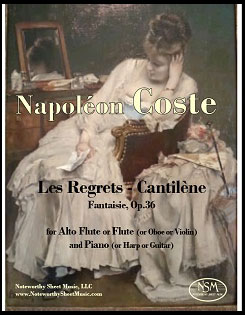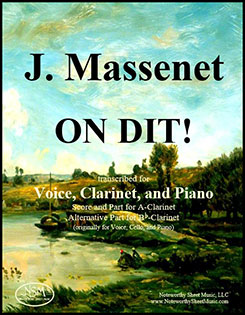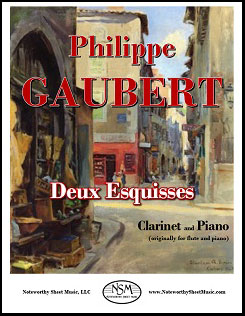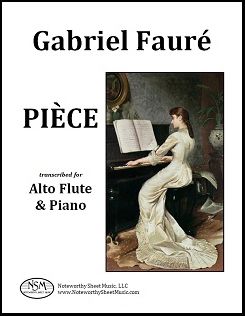French
-
Coste - Les Regrets - Afl or Fl (or Ob, Vn) and Pf (or Guitar, Harp)
 Les Regrets-Cantilène, Op.36, by Napoléon Coste
Les Regrets-Cantilène, Op.36, by Napoléon CosteTranscribed for Alto Flute or Flute (or Oboe or Violin) and Piano (or Harp or Guitar) by C.A.Vater
Score, Alto Flute Part, and alternative Flute (or Oboe or Violin) Part, PDF $5.99
Napoléon Coste (1805-1883) became famous not only as a guitar soloist, but also as a major composer of some 60 works, most of which were written for guitar. His music is in the romantic French style and appreciated for its originality. His Fantaisie, Op.36, Les Regrets-Cantilène, is a short, single-movement piece written for oboe or violin with piano or harp or guitar. We created our Noteworthy Sheet Music edition from the difficult-to-read manuscript version in the public domain, available on imslp.org. We include a score in concert pitch and a part suitable for flute, oboe or violin, as well as a part transcribed for alto flute in G. The piece falls nicely within the sweet range of the alto flute and our transposition sounds appealing and completely natural on that instrument. In fact, Les Regrets-Cantilène is gorgeous on either flute or alto flute. Melodic and sentimental, the work is not overly demanding technically and should appeal to players of a moderate or higher skill level.
Preview
Score, 4 pages; Alto Flute part, 1 page; Flute (or Oboe or Violin) part, 1 page; Total 8 pages. -
Massenet - On Dit! - trans. Clarinet, Voice and Piano
 On Dit!, by Jules Massenet
On Dit!, by Jules MassenetTranscribed for Clarinet, Voice and Piano by C. A. Vater
Score for Clarinet, Voice and Piano; Alternative Parts for A-Clarinet and B-flat-Clarinet, PDF $8.99
Massenet’s composition On dit! is a musical setting of the eponymous poem by Jean Roux in which the poet ponders how the word “love” is commonly and inevitably associated with the sweetness and delights of spring. In addition to the vocal line and piano accompaniment, Massenet provided On dit! with a prominent part for cello. The cello line can be readily adapted for clarinet, creating a lovely and suitable new version of the piece for clarinet, voice, and piano. Our Noteworthy Sheet Music edition includes a score in concert pitch, as well as individual parts for either A-clarinet or B-flat-clarinet transcribed from the original cello part. Clarinetists in possession of both A and B-flat instruments may develop a personal preference for playing this piece on one instrument over the other, based on tone quality, complementarity with a particular singer’s sound, etc.
Score, 5 pages; A-Clarinet Part, 2 pages; B-flat-Clarinet Part, 2 pages; Total, 16 pages.
Preview -
Gaubert - Deux Esquisses - Clarinet and Piano
 Deux Esquisses, by Philippe Gaubert
Deux Esquisses, by Philippe Gauberttranscribed for Clarinet and Piano by C. A. Vater
Clarinet part and Piano score, PDF $9.99
Philippe Gaubert was a prominent French flutist, composer, and conductor who held a professorship at the Paris Conservatory and principal conducting positions at the Paris Opéra and the Orchestre de la Société des Concerts du Conservatoire. We’ve created a transcription of his Deux Esquisses (Two Sketches) for B♭ clarinet, complete with piano score. These pieces were written for flute and piano but are nicely adaptable for other winds. They were originally published by Heugel & Cie, in 1915 (No.1) and 1914 (No.2), and are now in the public domain. No.1, Soir sur la Plaine (Evening on the Plain), opens intriguingly with the solo instrument playing alone, repeating a single note. This motif sets the lovely, mysteriously forlorn tone of Soir sur la Plaine, and returns multiple times later in the piece. No.2, the second sketch, is Orientale, which, as its name suggests, evokes an atmosphere seemingly strange and foreign, Eastern.
Piano Score, 10 pages; Clarinet part, 4 pages; Total, 20 pages.
Preview -
Fauré - Pièce - Alto Flute & Piano
 Pièce (Vocalise-Étude), by Gabriel Fauré
Pièce (Vocalise-Étude), by Gabriel FauréTranscribed for Alto Flute and Piano by C.A.Vater
Alto Flute Part and Piano Score, PDF $4.99
Vocalises are songs without words written to provide technical challenges for singers; they are designed to develop flexibility and control, and thus often serve as vocal warm-up exercises. Gabriel Fauré composed his Vocalise-Étude in 1906, and it was published by Leduc the following year. The original piece, in the key of E minor and marked Adagio molto tranquillo, includes a piano accompaniment and incorporates various difficulties for the vocal soloist, including wide intervals, unexpected harmonies, and demanding rhythms.
Fauré's Vocalise-Étude has long been recognized as a particularly lovely and poignant piece of music, not merely a vocal exercise but a musical work of intrinsic beauty. Under its alternative name Pièce, the Vocalise-Étude has been transcribed for various orchestral instruments, including bassoon and piano, flute and piano, and oboe and harp. We at Noteworthy Sheet Music think the alto flute, with its rich, mellow tone, is the perfect instrument for this moving and somewhat melancholy Fauré melody. Our transcription for alto flute and piano is based on the version of the Vocalise-Étude for medium voice, in the key of D minor, published by Alphonse Leduc in 1907 and now in the public domain.
Alto Flute part, 1 page; Piano Score, 3 pages; Total, 8 pages.
Preview